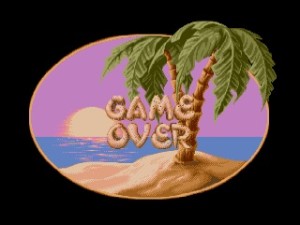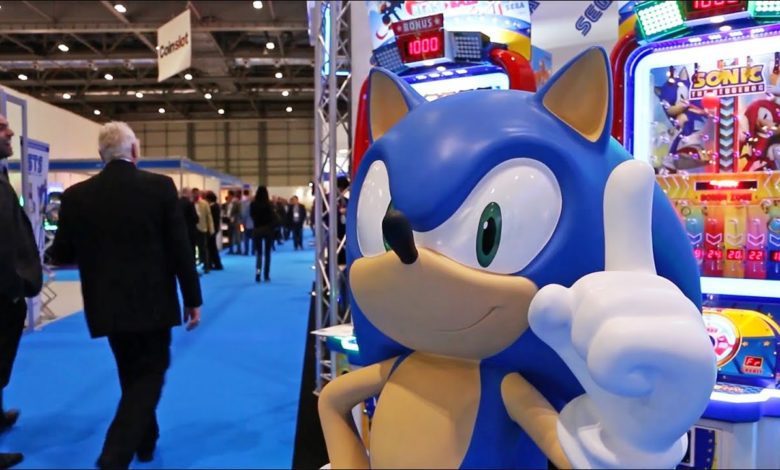
What is… PUGGSY: A retrospective of Traveller’s Tales hidden gem
We all remember Puggsy, right? Anybody? Okay then. Perhaps not everybody remembers Puggsy, but I certainly do.
In this article, I hope to educate keen retro SEGA Nerds such as yourself on one of the great titles of my childhood. I believe Puggsy is criminally under-appreciated and is often overlooked when it comes to notable SEGA Genesis/SEGA Mega CD games. Hopefully, this article will inspire people to pick up their pads and jump right into this quirky adventure across a bizarre alien world.
There are plenty of compelling game mechanics, some stunning visuals and a soundtrack that gives even Treasure a run for its money. It’s everything you need for an awesome trip back to 1993, and to make things that little bit sweeter, it’s cheap to a pick yourself up a copy online too!
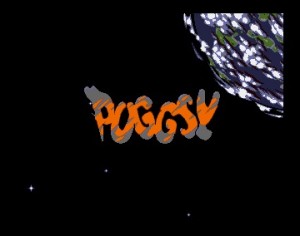
Let us start with the people behind Puggsy. It was humble beginnings for Traveller’s Tales. Business was different for the company in 1993. There were far less staff as the studio was only into its second year of being part of the games industry. With only two titles behind them, Leander and Bram Stoker’s Dracula, the small crew of talented individuals set forth to create something new. Psygnosis, who like Traveller’s Tales was also a British company, clearly believed in the studio’s work. The studio had worked with publisher Psygnosis on both of its previous titles, and this was not to change any time soon.
Its next game was to feature a brand new mascot character. This was risky business in the early ’90s. Everybody and their grandma was working on a mascot game, all striving to be the next Super Mario or Sonic the Hedgehog. Due to the amount of company mascot character games on the market, competition was fierce and getting noticed was not an easy task. Successful video game characters had to be visually appealing to children, having some iconic features that would allow them to stand out from the legions of others.
Unfortunately, Puggsy himself did not have much going for him. Not only did he resemble a tremendously out-of-date 1970’s space hopper, he also had stumpy little arms and legs along with a enormous nose. Still, Puggsy is an alien after all. While he may not have the cool attitude of a certain blue hedgehog or the jumping skills of a particular plumber, he makes up for it with his smarts.
Let’s take a look at the story. While it’s nothing ground breaking, it serves its purpose, fits the game well and serves for some humorous mini cutscenes between worlds. Puggsy is flying through space on a journey back to his home world, which is to take him 15 light years for anybody who might be counting. Suddenly, disaster strikes! Much to his dismay, he is ambushed by a band of villainous space pirates on his way through an asteroid field. After the enemies laser fire makes a direct hit on Puggy’s spacecraft, our hero has no other option than to crash land on a nearby planet.
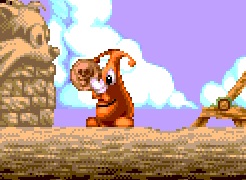
After jumping ashore and looking for supplies, it isn’t long before good ol’ Puggs attracts the attention of the planet’s inhabitants. A mischievous tribe of raccoons have their eye on his ship, and before you know it, they’re hauling it back to their chief by carrying it above their shoulders in a comical fashion. Puggsy must now use whatever he can find to take his ship back from the pesky raccoons. To make matters worse, he’s also somehow managed to anger the world guardians, all of which challenge him to battle at the end of each world. Somebody give this guy a break!
Okay, I hear you asking, “It’s yet another mascot character title, and there are hundreds of them. What makes this one stand out from the rest?” Thankfully, many things.
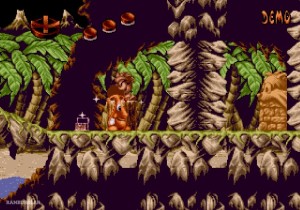
Puggsy has a sort of mock physics engine, a rarity in two-dimensional platformers of the time. Players take control of our alien friend and are able to pick up objects found scattered throughout each stage. This was dubbed TOI (total object interaction), and it’s an impressive feature. The goal is simple: navigate through each stage making use of the items found in each to solve puzzles. It starts off simple: pick up a seashell, use it to flick a switch, unlock a gate and go through the exit. Don’t be fooled, though. It soon becomes difficult, with players having to rack their brains if they wish to escape each stage.
Some of the later stages involve using the items in very cool ways. For example, the Darkskull Castle world has a stage that is incredibly dark. Players must shine a torch around the environment to find hidden letters. The letters must then be assembled into a word and said word is then used to unlock the exit. Another stage, part of a section in Badger Mill, has players baking bread. By placing flour on a conveyor belt and processing it through a machine, Puggsy is able to use the loaf to gain access the final room and escape the mill. Be careful not to make any mistakes though, otherwise the bread will be burnt to ash and Puggsy’s hopes of freedom will be dashed.
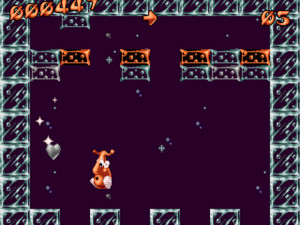
A level in Redwood Keep has players making use of spy cameras, which allow them to follow a bouncing ball around the environment. By using the camera along with a series of switches, it’s possible to control the ball through otherwise inaccessible areas, triggering switches to eventually break down the castle door.
There are many varied locations, with two or three stages found in each. The small amount of stages per location helps to mix the visuals up a bit. Nothing ever feels over-done or tedious, which is something I really appreciate, especially considering it’s part of the puzzle platforming genre.
There is a constant sense of wonder with every new stage. What purpose does each item serve? What properties do they have? What happens if I throw it at a wall, will it break, will it bounce? It’s all very clever, and it never stops being entertaining.
Believe it or not, our little orange friend had an unreleased title. It even pre-dated Puggsy on the Genesis. In fact, the character was not even a creation of Traveller’s Tales, and it wasn’t until they first bought the license that they developed Puggsy.
The video you can see above is part of a pitch video for an Amiga title. Named Puggs in Space, this demo may not look like much today, but it boasted impressive animation and sound for the hardware it is running on.
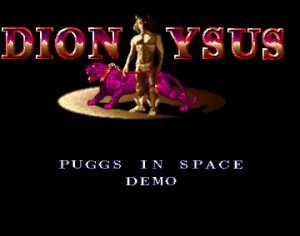
Puggs in Space was to be an exploration adventure title, with players taking control of our hero and navigating around a strange alien world. The concept is very similar to that of the later released Puggsy, and it was no doubt that this demo was used as a basis to work from. Despite drumming up quite a lot of interest amongst Amiga and retro gaming enthusiasts in recent years, at the time, the game was never really able to get off the ground. Unfortunately, Puggs in Space ended up serving nothing more than being a conceptual video to help sell the IP.
Despite this, the short demo did help launch the careers of the development staff behind it. Ian Hetherington, the then director of Psygnosis, had a large part in all of this. After seeing the demo at a London Computer Fair, it’s said that he was so impressed, he decided to sign all three members of the team up to Psygnosis on the spot; I can only imagine how exciting that must have been for those behind the demo.
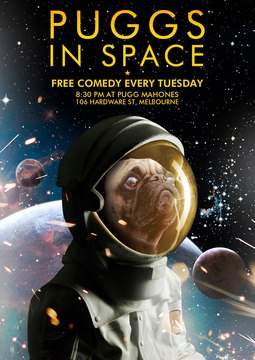
Speaking of which, let’s take a quick look at each member of the team. Alan McCarthy is the first of these three individuals, and he went on to work for companies such as Millennium Interactive, Electronic Arts and ultimately, Sony. He’s credited as a programmer in the Amiga title The Adventures of Robin Hood, and he’s worked on popular Sony franchises such as MediEvil and LittleBigPlanet. Lee Carus, the sole artist on the project remained at Psygnosis for a good while. It was there he found himself working on projects such as Shadow of the Beast and Colony Wars. He remained working at the company once they became SCE Studio Liverpool and continued as a graphics artist on titles such as WipEout and Killzone. Since then, he’s co-founded his own studio along with Graeme Ankers, named Firesprite Games. They developed the recent title The Playroom for the PS4.
Finally, we have Tim Wright, who composed both the music and sound effects for the demo, and this was his break into the industry. Puggs in Space served as the first video game Wright was to compose for and he has worked on more than 70 titles since. Some notable ones include Lemmings, Shadow of the Beast and WipEout. Wright released an update of the original Puggs in Space music back in 2007, likely as a side project. It’s a lot of fun to hear what the game would sound like if released today, and it is a nice tribute to the demo that helped launch his career.
Now, let’s take a look at the game itself. There are three different versions of Puggsy available, two of which are ports of the original. The first was released in 1993 for the 16-bit home console, the SEGA Genesis.
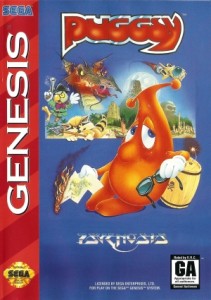
This was the original and perhaps the best version. Detailed visuals and a distinctive soundtrack by video game composer Matt Furniss helped create a wonderful looking and sounding world for Puggsy to play around in. It has a very similar feeling to another Genesis title, Wiz ‘N Liz. It will come to no surprise that despite being developed by a different studio, the publisher for both games was Psygnosis and quite a few of the staff from the Wiz ‘N Liz team helped out with Puggsy. In fact, you will notice cameos of characters from Wiz ‘N Liz in Puggsy and vice versa. We won’t tell you what exactly, as you should definitely play both titles and find out for yourselves!
As mentioned before, the gameplay of Puggsy involves picking up objects and using them to solve puzzles. The controls are simple; one button allows for Puggsy to jump, another for him to pick up/drop and object and the third to perform an action with said object. The actions performed vary greatly. Along their travels, players will pick up items, such as guns and water pistols which can be fired with this interaction button. In addition to this, mugs of booze can be thrown at enemies, balloons can be filled with air, matches can be lit and much more, all achieved with a press of this button.
Our little orange hero is not totally defenceless, as players are also able to jump on top of enemies heads. There’s a trick to it though, one I did not realise until years later. While in the jumping animation, players must hold down on the D-pad to successfully stomp foes. It is a bit of a pain, as holding directional down while jumping can restrict movement and makes it an impossible tactic in some situations. Oddly though, it fits well with the style of game Puggsy is, and it encourages players to use items and their cunning to defeat the bad guys instead.
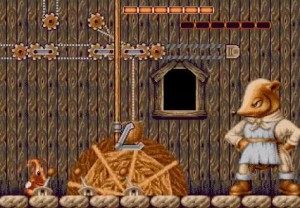
Puggsy is also able to give himself an extra hit, too. By donning a pair of handsome shades, an extra hit is given, meaning it will take two attacks to knock Puggsy off his feet. Speaking of his feet, he’s also able to locate and wear some pretty snazzy sneakers. These are a crucial power up as they not only give our hero another extra hit, but allow players to move more quickly. They are essential for navigating the larger stages, so it’s a godsend that there are plenty scattered around. It’s possible to use the empty shoe box as an object too, allowing you to stack them on top of one another and reach great heights!
In-between the stages, players navigate across a world map. Each stage is represented by a small yellow square, which later turns to white once beaten. Hidden stages can show up as all different types of colours, making them feel that little bit more special. There are a total of five boss battles found in the Genesis version of the game. All of the bosses tower above Puggsy, and players will have to make use of objects in the environment to defeat them. My favourite is no doubt the first boss, a peg-leg’d pirate parrot of whom you fight atop a rocking pirate ship on a stormy ocean.
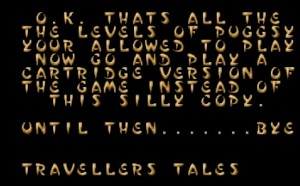
Unlike certain other SEGA Genesis games, Puggsy did not feature a save system. Instead, a tedious password system was put in place that required lengthy codes of 27 characters. What’s interesting to note is the game could have easily featured a save system. Instead, the developer opted to use the SRAM space for copy protection. If you are playing a pirated ROM of the game on an emulator, players are locked out after the first boss is defeated and the game gives you a stern talking to.
If you are to play Puggsy, we would strongly recommend the SEGA Genesis version above the rest. While it doesn’t have any extra content, the music sounds much better coming from the SEGA Genesis then it does the from CD or Amiga, and it makes a huge difference. The three button controls are straight-forward, and while the password system may feel tedious, we’re just happy there is one in place considering the size of the game and the complexity of the later puzzles.
Puggsy on the SEGA Mega CD released shortly after the SEGA Genesis version, also in 1993. The game features largely the same content, although it includes an extra few stages, boss battles and CD quality sound.
Boss battles have increased by three, with a giant crab, a rat in shining armour and a huge mechanical raccoon head added to the roster. All three of the bosses are a nice addition, although they are pathetically easy to beat.
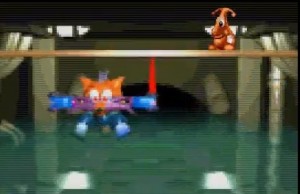
The mechanical raccoon boss makes excellent use of the SEGA CD’s additional processing power, featuring FMV quality visuals for the boss itself. Puggsy stands atop of a beam overlaying the FMV as the robot spouts bursts of fire up towards him. This boss is no doubt the easiest of the trio, as no direct attacks need to be made against him. Simply survive for a minute or so until the water below rises enough to engulf the robot and you’re golden. It’s a little disappointing a foe with such potential can be beaten so easily, although there was only so much that was achievable when using an FMV for a boss fight.
While we’re on the subject of FMVs, this version of the game also includes video cutscenes including an extended intro sequence. They are extremely basic, and due to this, lose a lot of the comedic value and charm of the ones included in the original SEGA Genesis version. The technology may be more impressive, but we would take simpler but nicer looking in-game cutscenes over FMV sequences any day.
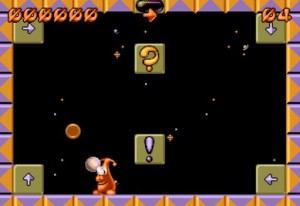
Then we have the music. Puggsy on the SEGA CD boasts impressive sound quality, however every track leaves something to be desired. The SEGA Genesis instruments sound far better fitting and memorable tracks such as the eerie Darkskull Castle sound superior on the older hardware. Furthermore, a lot of the tracks for later levels are missing. This isn’t the case in the original version, with stages such as Fire Heart having their own unique music. The SEGA CD version of this world replays the beach music from the first stage. Boo, hiss.
If you are able to pick up a copy for the SEGA CD, then we would still definitely recommend it. However, given the choice, we would suggest playing the SEGA Genesis version for the superior soundtrack. We’re also a little disappointed this version did not include a save system either. Had it included one of these systems, then this may well have been the version to recommend.
The Amiga version of Puggsy released a year later in 1994, and it is not half bad. The visuals, gameplay and music are all pretty faithful to the original, and while it isn’t on par with the SEGA Genesis version, we would still recommend giving it a shot.
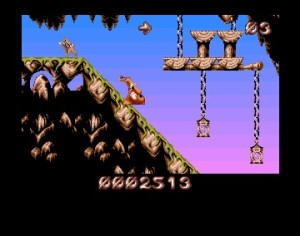
One of the major differences between the Amiga version and the original is of course, the graphics. While the sprites and foreground environments look more or less identical to that on the SEGA Genesis, the background graphics are instead replaced with simple colour gradients. It doesn’t detract too much from the gameplay however, which thankfully is all still intact. Even the map screen makes its reappearence here, and we’re less welcoming of the password system, which also makes its terrifying comeback.
Stages are identical to those in other versions, with the TOI system allowing for all of the tricky puzzles to return and baffle the Amiga crowd. The mock-physics engine works well on the Amiga, which once again was a rare sight to see on the system, even in 1994. The bosses look great too, with large moving sprites flying around the screen and even some fancy reflective water effects used during certain moments. Cutscene animations are no longer animated, though. Instead they are now replaced with static images, but it isn’t much of an issue.
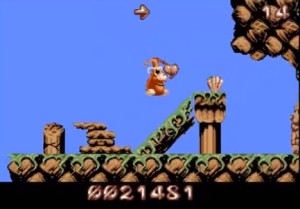
One aspect worth mentioning is the game’s performance. Users report that when running this game on the Amiga A500, slowdown can occur quite frequently. This isn’t an issue that occurs in either the SEGA Genesis or CD versions and as such we would recommend only playing this title on higher end Amiga computers.
If you have an Amiga and fancy a taste of Puggsy, we would suggest picking this version up. As with the SEGA CD version though, given the choice, we would stick to the SEGA Genesis original.
It’s a huge shame that this game often goes unnoticed. What is to blame for this? Probably a combination of many things.
Puggsy is certainly a weird and strange looking title, which is something that will not appeal to everybody. The character himself certainly isn’t visually appealing enough to be successfully marketable, and he just did not stand a chance when sat aside the iconic face of say, SEGA’s Sonic or Nintendo’s Super Mario. 1993 was also an unlucky year for smaller companies with new IPs as many huge game releases were hitting the market, such as StarFox, Sonic CD, Secret of Mana, Link’s Awakening, Mortal Kombat II and Day of the Tentacle, to name a few.
Still, we love the little fellow. Traveller’s Tales continued working with both Psygnosis and SEGA on several more titles. They developed 16-bit games for big name franchises such as Toy Story, Mickey Mouse and even Sonic the Hedgehog, bringing all new experiences to the SEGA Genesis and Mega CD.
There is something about Puggsy that makes it feel so unique, atmospheric and ultimately astounding. It not only remains today as one of my favourite titles on the SEGA Genesis, but also as one of my favourite video games of all time.
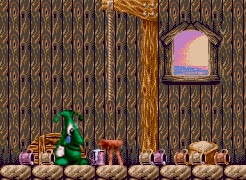
If you watched the video in the section above, you will have noticed some intriguing text during the credits:
Look out for Puggsy Part II coming soon!
Cool, right? Wrong. Part two never happened. Puggsy’s existence ceased to be after the first game, and it is mighty unfortunate. The developers behind it had moved onto bigger and better things, working with SEGA on various big name titles. It’s likely Jon Burton and Traveller’s Tales still hold the license to Puggsy, although it looks like he won’t be returning any time soon.
